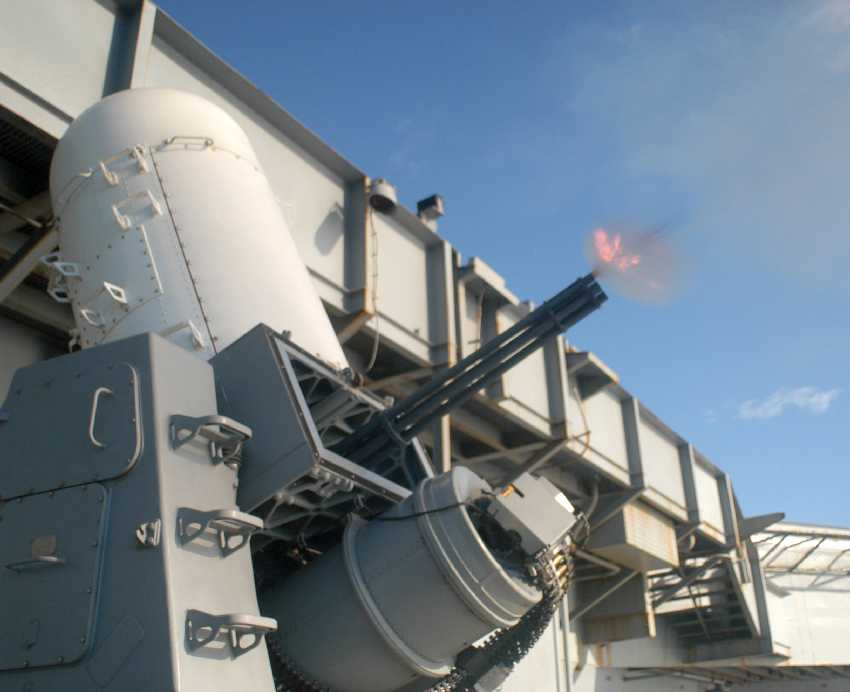
Close-in Weapon Systems (CIWS - usually pronounced "see-whiz") are designed to engage anti-ship cruise missiles and fixed-wing aircraft at short range. Phalanx is the most numerous CIWS in the world and has been exported to many other countries. Like other close-in weapon systems, Phalanx provides ships with a terminal defense against anti-ship missiles that have penetrated other fleet defenses.
Phalanx is very much a self contained system requiring minimal deck space and wiring. Unlike many other CIWS, which have separate, independent systems, Phalanx combines search, detection, threat evaluation, acquisition, track, firing, target destruction, kill assessment and cease fire into a single mounting.
A prototype unit was installed for evaluation purposes on USS King (DLG-10) in 1973. In 1975 another prototype was mounted on the hulked USS Alfred A. Cunningham (DD-752) while several different kinds of missiles were fired against it. All of these missiles, including a Walleye, were destroyed before reaching the ship. A pre-production Phalanx unit underwent operational tests and evaluation onboard USS Bigelow (DD-942) in 1977. These tests showed that the unit exceeded the required maintenance and reliability specifications. The evaluations included tests with high levels of jamming noise during which the unit succeeded in distinguishing small missile-like targets against nearby islands.
Phalanx Block 0 production started in 1978 with orders for 23 USN and 14 Foreign Military Sales (FMS) systems.
Phalanx Block 1 saw service introduction in 1988. Block 1 baseline 0 upgrades included a larger magazine (1,500 rounds), a multiple pulse repetition frequency search radar, an expanded radar search envelope to counter diving targets as well as reliability and maintainability improvements. Block 1 was also able to engage targets diving at steeper angles than Block 0 could handle. Block 1 replaced the 2-D scanning antenna of Block 0 with a four-plate back-to-back antenna that continuously searches from the horizon up to the vertical. The cease-fire protocol was changed to match the burst length to the type of target being engaged, thus conserving ammunition and allowing a greater number of targets to be engaged. In automatic control, the gun will prioritize the first six threats it sees at about 10,000 yards (9,100 m) and engage at 4,000 yards (3,600 m).
Block 1 baseline 1 replaced the hydraulic gun drive with a pneumatic (air-driven) gun drive system that increased the rate of fire to 4,500 rounds per minute. Search radar sensitivity was also improved in this upgrade. Block 1 baseline 2 introduced further reliability upgrades along with a muzzle restraint to decrease dispersion. As installed on multiple non-Aegis and Aegis ships, neither the original Phalanx Block 0 nor the subsequent Block 1 baseline 0, 1, or 2 upgrades were integrated with a ship self-defense system.
The Phalanx Block 1A incorporated a high-order language computer in order to better process engagement algorithms and provided improved performance against maneuvering targets. Block 1A also provided for basic integration with the Ship Self Defense System and enabled RAM missile engagement through the Phalanx detection and track function.
Block 1B improvements include Optimized Gun Barrels (OGB) and a new integrated forward looking infrared system (FLIR). The OGB are electrically controlled, pneumatically driven and fire a new Enhanced Lethality Cartridge (ELC). The Phalanx FLIR provides increased capability to search, track and engage coastal warfare threats as well as provide better anti-ship missile defense. Phalanx Block 1B saw service evaluation in 1999 aboard USS Underwood (FFG-36) and was first operationally installed on USS Taylor (FFG-50) in September 2000.
As of February 2007, about 900 Phalanx systems have been built and deployed in the navies of 22 nations. More than 3 million rounds of ammunition have been manufactured specifically for these weapons.
In recent years, the Vulcan 20 mm gun that is the heart of this weapon has increasingly been seen as not being effective enough against modern missile threats. However, the British Royal Navy did select Phalanx for their new Daring class Type 45 destroyers.
Phalanx is somewhat notorious for having maintenance problems, with the Navy's Material Readiness Database for fiscal years 1997 through 1999 noting that Phalanx Block 1B (all mods) had an availability rate of between 72 and 81% for this time period.
An interesting modification of Phalanx that recently entered service with the US Army is the Counter-Rocket Artillery Mortar system (C-RAM), which is designed to combat the small mortar and rocket threat. This system grew out of a 2004 request from Army Chief of Staff General Peter Schoomaker, who wanted a better means of defending US troops based in Iraq.
The complete C-RAM system networks a ground-based version of Phalanx together with the Army's Lightweight Counter Mortar Radar (LCMR) and Q-36 Target Acquisition Radar (AN/TPQ-36 Firefinder Radar), which detects incoming rounds and determines their point of origin. When C-RAM detects an incoming round, it turns on a set of strobe lights to alert local personnel to take cover, authorizes the modified Phalanx to open fire with explosive bullets to destroy the projectile and dispatches a Hunter UAV equipped with Viper Strike laser-designated munitions to kill whoever fired it. Raytheon is currently (2007) offering a trailer-mounted version of Phalanx as part of C-RAM under the product name of CenturionTM. Unlike the naval version, the C-RAM version of Phalanx does not fire solid tungsten penetrators. Instead, in order to reduce the risk of civilian and friendly casualties, this system uses self-destructing explosive bullets.
The first two C-RAM systems arrived in Iraq in May, 2005 and have been reported as having successfully knocked down incoming mortar rounds.
In September 2006, it was reported that the Israeli military expressed an interest in this weapon as well as in Skyshield, the land version of the Millennium system.
Nomenclature Note: The Phalanx system is designated as the Mark 15. The CIWS mounting itself is designated as the Mark 72.
For additional information, see the Essay on the Naval Technical Board.
| Designation | Block 0 1 and Block 1 Gun Type: 20 mm/76 M61A1
2 Block 1B Gun Type: 20 mm/99 M61A1 Gatling OGB 1 Mounting: Vulcan Phalanx Mark 72 |
|---|---|
| Ship Class Used On | Most major warships from 1980 onwards |
| Date Of Design | 1969 |
| Date In Service | Block 0: 1980 aboard USS Coral Sea CVA-43
Block 1: 1988 aboard USS Wisconsin BB-64 Block 1B: 1999 aboard USS Underwood FFG-36 (operational in 2000 aboard USS Taylor FFG-50) |
| Gun Weight | N/A |
| Gun Length | N/A |
| Bore Length | Block 0 and Block 1: about 59.8 in (1.520 m)
Block 1B: about 78 in (1.981 m) |
| Rifling Length | N/A |
| Grooves | N/A |
| Lands | N/A |
| Twist | N/A |
| Chamber Volume | N/A |
| Rate Of Fire 3 | Block 0: 3,000 rounds per minute cyclic
Block 1 and Block 1B: Selectable 3,000 or 4,500 rounds per minute cyclic |
- ^The original M61A1 gun barrels were designed for short bursts and were subject to wear and increased dispersion patterns. The new Optimized Gun Barrels are 18 inches (46 cm) longer, substantially thicker and include a barrel brace and a muzzle restraint to both improve life expectancy and reduce projectile dispersion patterns.
- ^Phalanx Block 0 could fire either continually or in bursts of 60 or 100 rounds. The air-driven guns in Block 0 and Block 1 baseline 0 took as much as half a second to spin up to full speed, limiting the number of rounds they could fire during that time. Later Blocks use pneumatic power which allows them to spin up to full speed in a much shorter time period as well as giving them a higher ROF.
| Type | Fixed |
|---|---|
| Weight of Complete Round | Mark 149: 0.58 lbs. (0.263 kg)
Mark 244: N/A |
| Projectile Types and Weights 1a 2a | APDS Mark 149 3a - 0.22 lbs. (0.10 kg)
APDS Mark 149-2 - 0.22 lbs. (0.10 kg) APDS Mark 149-4 - 0.22 lbs. (0.10 kg) APDS ELC Mark 244-0 - 0.33 lbs. (0.15 kg) |
| Bursting Charge | N/A - Solid Tungsten Penetrator |
| Projectile Length | 6.62 in (16.8 cm) |
| Propellant Charge | N/A |
| Cartridge | 20mm x 102 |
| Muzzle Velocity | Mark 149: 3,650 fps (1,113 mps) |
| Working Pressure | N/A |
| Approximate Barrel Life | N/A |
| Ammunition stowage per gun | Block 0: 989 rounds per magazine
Block 1: 1,550 rounds per magazine |
- ^The Mark 149 projectile was developed to provide a significantly increased anti-armor capability, optimized exterior ballistic performance and short time-of-flight over the previous Mark 50 round. The original Mark 149-2 projectile was a depleted-uranium sub-caliber penetrator. In 1988, the Navy switched to the Mark 149-4 which uses a tungsten penetrator. The Navy changed over to tungsten in order to reduce radiation exposure to personnel and lessen the environmental impact. Tests with the tungsten penetrator showed acceptable results against likely missile and aircraft threats. The Mark 149-4 round includes a red tracer.
- ^The Mark 244 Mod 0 ELC (Enhanced Lethality Cartridges) uses a heavier optimized tungsten alloy penetrator that extends the effective range of this weapon. However, these rounds have been found to increase the likelihood of jams in the ammunition feed system. These jams were the result of the cartridge case getting dented when it was trapped between the feeder unload sprocket and the guide bar just after handoff from the gun bolt. This problem was traced back to the new round having a different center of gravity than previous rounds, which causes the Mark 244 to be mis-positioned in the feed system during the handoff. Alterations of the feed sprocket wheels and guide bars have been recommended to reduce the problem.
- ^The sub-caliber penetrator of the Mark 149 is 0.502 inches (12.75 mm) in diameter.
- Block 0 took two men 10 to 30 minutes to change the magazine. Block 1 greatly reduced reload time to less than five minutes by using a pre-loaded ammunition cassette.
- Phalanx for C-RAM uses M246 HEI-TSD or M940 MPT-SD rounds. As C-RAM is not a naval application, I do not include these rounds in the table above. As some general comments, the M940 is said to be effective against mortar rounds at ranges up to 2,200 yards (2,000 m) and has a time of flight at that range of 3.69 seconds.
| Elevation | Range |
|---|---|
| 45 degrees | 6,000 yards (5,500 m) |
| Maximum effective range | 1,625 yards (1,490 m) |
| Designation | Phalanx Mark 72
Aircraft Carriers (3-4), Battleships (4), Cruisers (2), Destroyers (2), Frigates (1), Amphibious Command Ships (2), Helicopter Carriers (1-2), Amphibious Transport Docks (2), Dock Landing Ships (2), Tank Landing Ships (1), Ammunition Ships (2), Combat Stores Ships (2), Combat Support Ships (2), Replenishment Oilers (1), Coast Guard High-endurance Cutters (1) |
|---|---|
| Weight 1b | Early models: 12,500 pounds (5,625 kg)
Later models: 13,600 pounds (6,120 kg) |
| Elevation | Block 0: -10 / +80 degrees
Block 1: -20 / +80 degrees Block 1B: -25 / +85 degrees |
| Rate of Elevation 2b | Block 0: 86 degrees per second
Block 1B: about 115 degrees per second |
| Train | about -150 / +150 degrees |
| Rate of Train 2b | Block 0: 100 degrees per second
Block 1B: about 115 degrees per second |
| Gun Recoil | N/A |
- ^Weight of Block 0 was split 12,000 lbs. (5,443 kg) above deck and 466 lbs. (211 kg) below.
- Standard manning of early mountings was three enlisted men. Later versions may have only a single crewman at a monitoring station, but do require at least two additional personnel in order to change out the ammunition cassettes.
- The mounting train and elevation motors are electrically driven and the system requires 440 Vac 60 Hz line power. Block 1B consumes 18 KW while in search mode and 70 KW while in track mode.
- Search radar is Ku-Band, Digital MTI while the track radar is Ku-Band, Pulse Doppler Mono-pulse.
- Although the gun barrels are air-cooled, the electronics require a sea-water cooling system that is rated at 20 gpm, 30 psig (30 lpm, 2 kg/cm2).


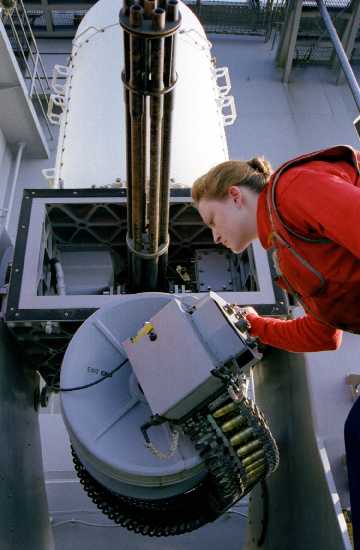
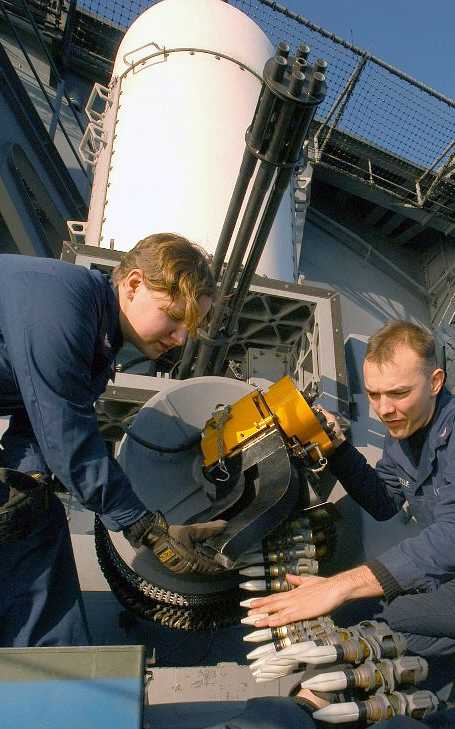
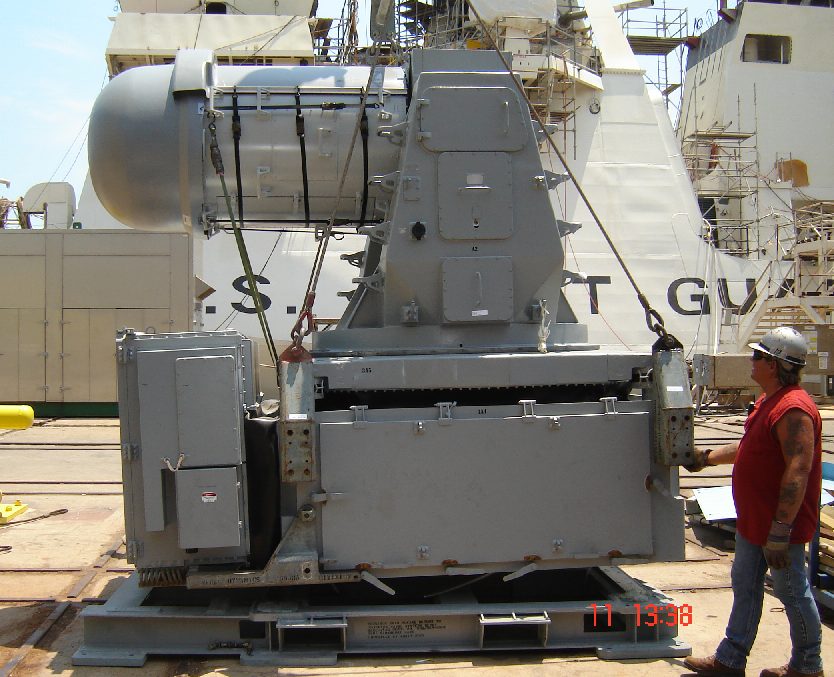
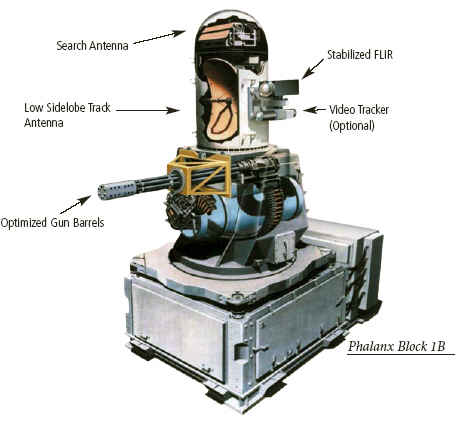
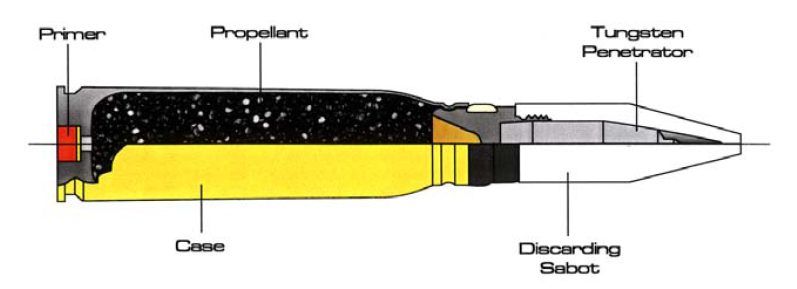
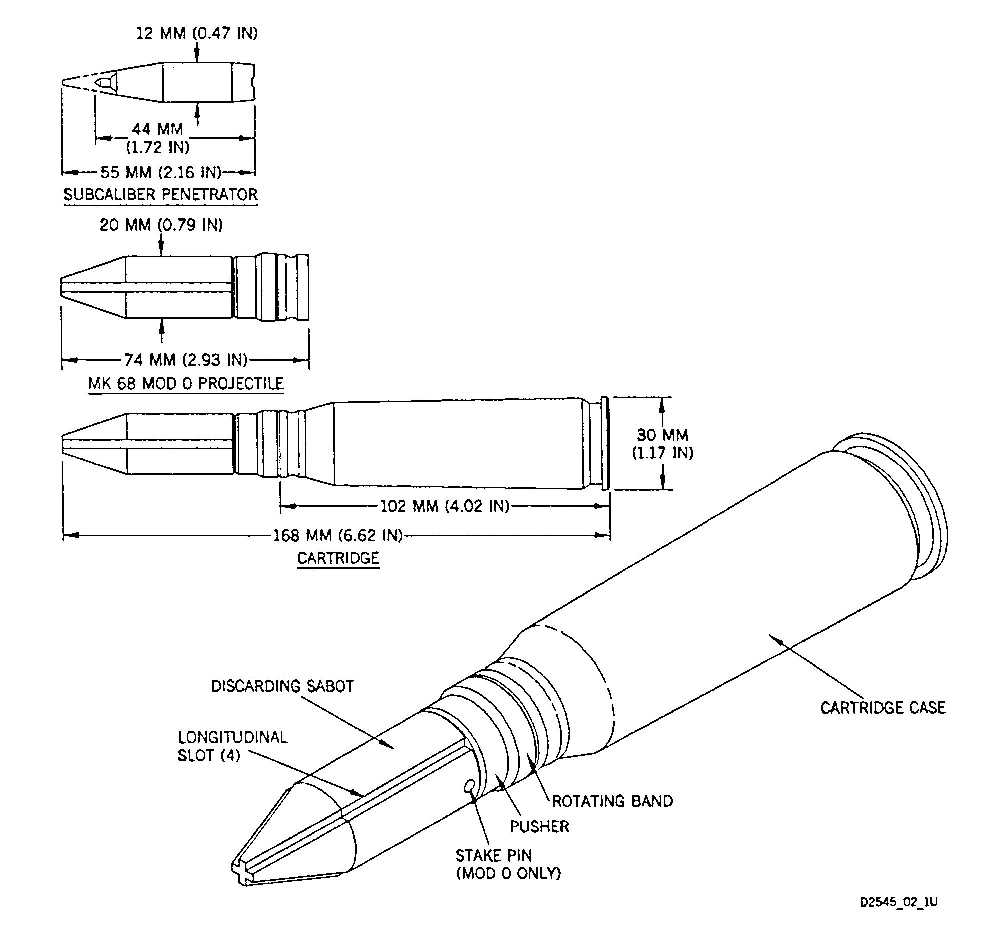
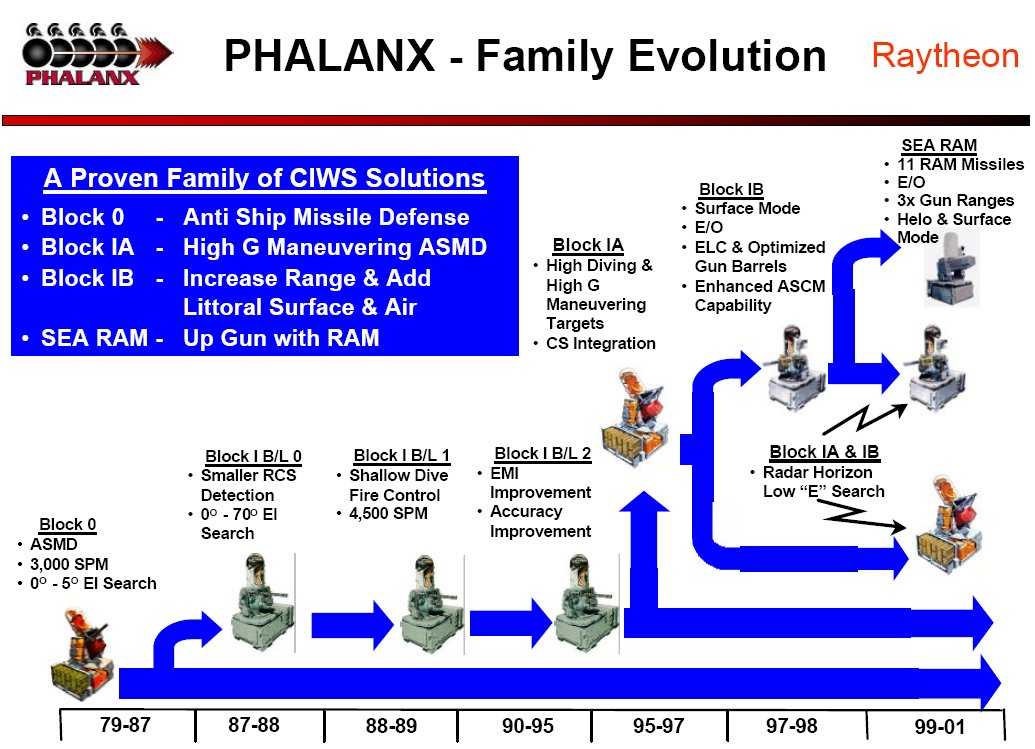
"The Naval Institute Guide to World Naval Weapon Systems 1991/92" and "US Naval Weapons" both by Norman Friedman
"Jane's Ammunition Handbook: Ninth Edition 2000-2001" edited by Terry J. Gander and Charles Q. Cutshaw
"Defense Acquisitions: Comprehensive Strategy Needed to Improve Ship Cruise Missile Defense" - GAO report GAO/NSIAD-00-149
---
"Phalanx Close In Weapon Support (CIWS) Dented Brass Dynamic Analysis" by Mr. John Fletcher, GDATP, presented at the NDIA 41st Annual Armament Systems: Guns and Missile Systems Conference & Exhibition
"20mm M940 MPT-SD vs. M246 HEI-TSD Ground to Air Performance Comparison" by Don Dillard, GDOTS, presented at the NDIA
41st Annual Armament Systems: Guns and Missile Systems Conference & Exhibition
---
General Dynamics Company Press Releases
Raytheon Systems Company Press Releases
General Dynamics Company - Ordnance and Tactical Systems Press Releases
US Navy Press Releases
---
Defense News article of 13 June 2005, "Naval Gatling Gun Given Anti-Mortar Role"
Jerusalem Post article of 05 September 2006, "Skyshield air defense being considered"
02 November 2007 - Benchmark
29 October 2009 - Added Evolution Sketch
16 June 2010 - Added links to Essay on Naval Technical Board and sketch of Mark 149
01 August 2016 - Converted to HTML 5 format
05 March 2018 - Reorganized notes
06 January 2022 - Updated to latest format
08 August 2022 - Added link to History and Technology Essay
